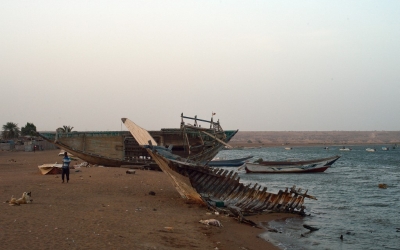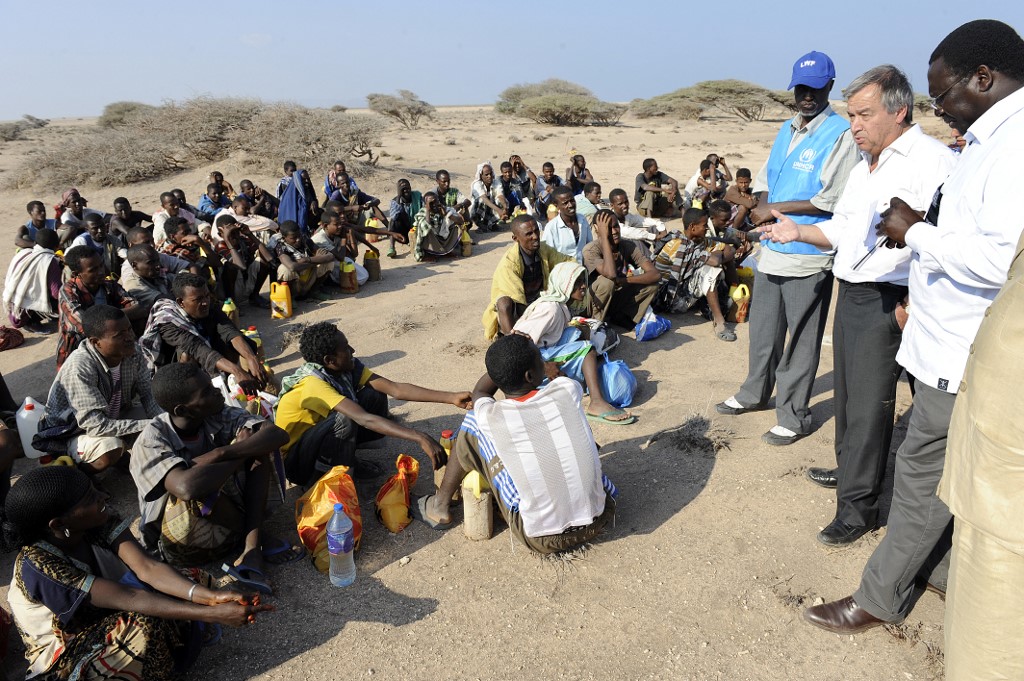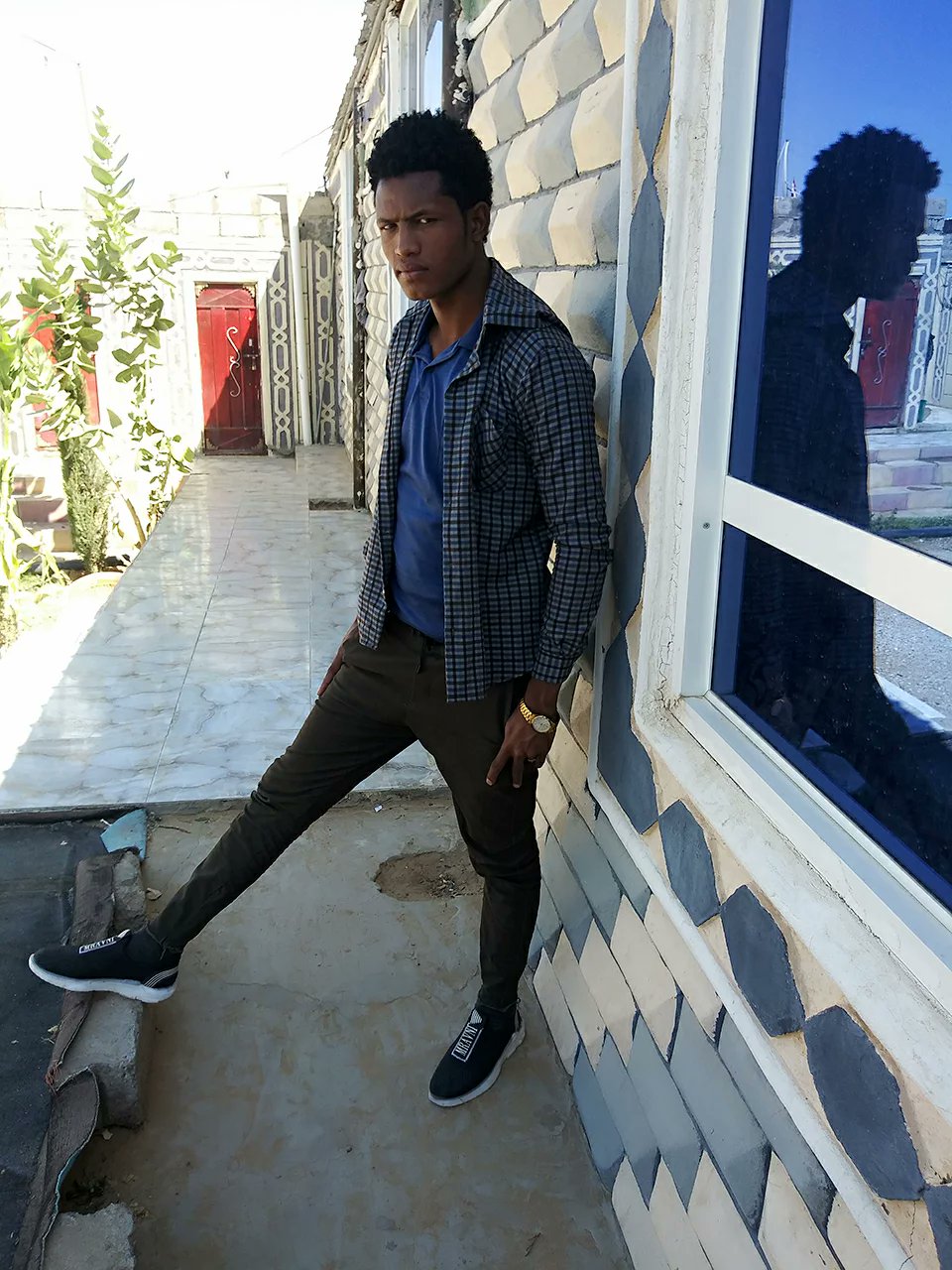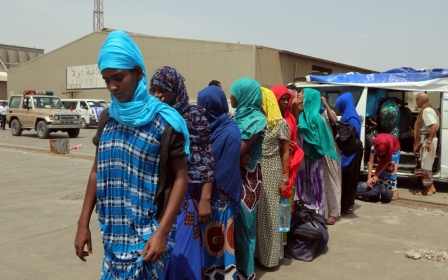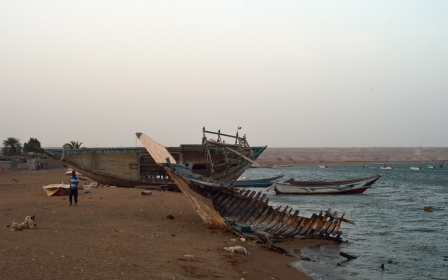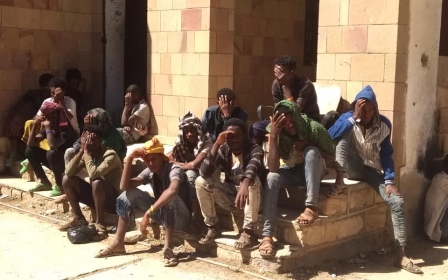Yemen: Sanaa migrant centre fire survivors grieve as death toll mounts

It was just after midday on Sunday when smoke began to billow from an immigration detention centre in the Yemeni capital, Sanaa.
Ahmed, a Yemeni who lives near the facility, watched from his window as civil defence members battled the flames.
"We are used to seeing a similar type of smoke after an air strike, but we heard no sound before the smoke," he recounted to Middle East Eye.
"Many people thought it was an air strike because warplanes were flying over Sanaa," he said. "Ambulances and water trucks tried for hours to extinguish the fire before it finally stopped."
Local officials from the Houthi rebel movement and the UN's International Organisation for Migration (IOM) said the fire had killed at least eight people and left 170 others injured, with some still in a critical condition.
But footage obtained by Middle East Eye of the fire's aftermath appeared to indicate that the death toll is significantly higher than previously reported.
A two-minute video clip showed charred bodies of dozens of victims, most of whom are reportedly Ethiopians. Filmed inside the confines of a dimly lit cell, migrants who survived the fire can be seen wailing with grief in Afaan Oromo, one of Ethiopia's most spoken languages. Coughing and screaming can be heard as migrants wade through burnt mattresses drenched in mud and human remains.
'The prisoners stood no chance'
Two Ethiopians who survived the fire told MEE that it was triggered by a security guard firing a projectile into the crowded cell during a protest by detainees against poor living conditions.
"You can see some were crying because they had found their brother or cousin among the burnt bodies," said Ali, one of the survivors. "Others just fainted because they inhaled so much smoke at the scene and were in complete shock."
Ahmed Abdulrahman, a representative of the Ethiopian community in Yemen, said detainees told him that Houthi forces fired a smoke bomb, which sparked flames that spread rapidly because of the overcrowded conditions.
"The prisoners stood no chance in the extremely cramped conditions and were burnt alive because of it," said Abdulrahman, who is based in Sanaa.
"Many of the detainees had been rounded up over the past month as part of a campaign to crack down on undocumented migrants."
The Houthis who run the facility held the detainees in a hangar and building inside the immigration authority's holding facility. The rebel movement, which controls Sanaa amid an ongoing war, rejected claims that it was responsible for the fire, and said it was investigating the incident.
In recent years, thousands of people from across east Africa hoping to cross into Saudi Arabia have got stuck in Yemen. Hundreds of them were transferred over the past few years to the Sanaa centre, which officials say is overcrowded. The IOM said that nearly 900 people were held in the facility when the fire occurred.
Abdulrahman and other eyewitnesses have accused the IOM of downplaying the death toll, claiming it is much higher than initially reported.
The IOM has denied that it ran the holding facility, but said it had been given access to the centre by the Houthis in order to provide detainees with emergency care, clothing, hygiene kits and mattresses.
Olivia Headon, IOM's spokesperson in Yemen, also said the organisation was not "downplaying" the death toll. "We initially said eight because that was the number of bodies seen by our staff, and when we said the death toll was higher, we meant significantly higher," Headon told MEE.
"When the fire happened, there were 350 people in the facility and 170 treated for injuries. We were able to respond to the scene immediately and deploy transport to take people to the hospital."
Abdulrahman and other Ethiopian community groups in Yemen believe the death toll to be in the hundreds, but have been unable to confirm the number because Houthis have refused them access to the medical centres. The IOM also said Houthi authorities have denied it access to hospitals after it delivered medicine to help burns victims.
With no confirmed death toll, relatives in Ethiopia fear the worst for their loved ones stuck in Yemen.
Siraj Mamo, who hails from the Ethiopian town of Dukem, has not heard from his nephew, Murad Kamal, for more than a week. For the past three months, Murad lived in Sanaa as an undocumented worker. He had told his family that he would try to flee Sanaa as a crackdown on undocumented migrants intensified.
"We had been told Murad was rounded up," said Mamo. "His phone no longer rings when we call it, and with news of the fire, the uncertainty is torturing his mother."
Blame game
Houthi authorities have blamed the IOM for the fire, saying the organisation had failed to repatriate detainees, leading to overcrowding inside the detention centre.
The IOM responded on 7 March, the day of the fire, and said it was "working with the government of Ethiopia to restart its Voluntary Humanitarian Return [VHR] programme to the country, which has been on hold since the pandemic".
It added: "In Aden alone, over 6,000 people have been registered to return; 1,100 are expected to do so in the coming weeks. IOM has also been discussing the resumption of a humane voluntary returns process with the authorities in Sanaa."
'We had been told Murad was rounded up. His phone no longer rings when we call it, and with news of the fire, the uncertainty is torturing his mother'
- Siraj Mamo, nephew of missing man
A letter dated 9 March seen by MEE showed Houthis asking Ethiopian officials to take back its nationals.
MEE was unable to reach the Ethiopian foreign ministry for comment by the time of publication.
The fate of the migrants held in the Sanaa detention centre is a tragic reminder of the difficult conditions that led them there. Thousands have used smugglers to cross the Red Sea from east Africa to find work inside the Gulf kingdom. Yemen is the only way for them to get to Saudi Arabia, with many also using the war-stricken country as a transit point to save up money before going into the oil-rich kingdom.
But when Covid-19 struck, Saudi Arabia closed its borders, leaving hundreds stranded in Yemen. Some took the perilous journey back to east Africa. Others had no choice but to stay in Sanaa, hoping for the Saudi border to open, or to be repatriated.
Yemenis in southwestern Lahj province and other coastal areas often see migrants walking in groups with no belongings except water. Most cannot speak Arabic, often asking the question "Which way is Saudi Arabia?" when they come to a city or village.
Osama Abdulhamid, an aid worker based in Yemen, said the vast majority of people coming to Yemen do so at significant personal risk.
"The immigrants go through dangerous risk to get here. Some are thrown to the sea by smugglers and then walk on foot in dangerous places to get to Saudi Arabia," Abdulhamid told MEE.
"We know there is fighting on the border between Yemen and Saudi Arabia. It is not easy to get to Saudi, but immigrants try to anyway."
Middle East Eye propose une couverture et une analyse indépendantes et incomparables du Moyen-Orient, de l’Afrique du Nord et d’autres régions du monde. Pour en savoir plus sur la reprise de ce contenu et les frais qui s’appliquent, veuillez remplir ce formulaire [en anglais]. Pour en savoir plus sur MEE, cliquez ici [en anglais].


